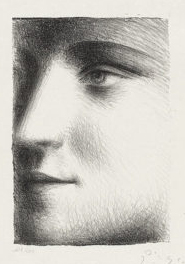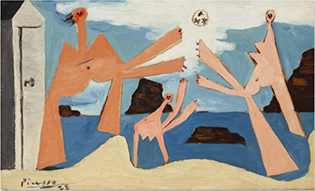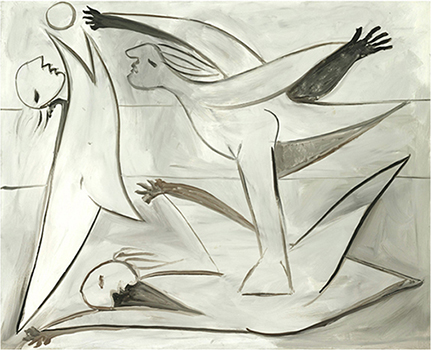In hindsight it is now clear that Picasso successfully camouflaged Marie-Thérèse’s identity within conceptual and stylistic codes and it was not until the late fifties that her identity emerged and she was credited as his primary inspiration during the 1930s. Having said that, Picasso must have given way to an irresistible urge to tease or court danger when he allowing a realistic lithographic portrait of her, simply titled Face, to appear in André Level’s 1928 publication Picasso (Fig. 5).
Une Anatomie, Bathers and the Femme Phallus
Richardson never clarified why he believed the “pinheaded female figures” were “conceptual sculptures” based on Marie-Thérèse, therefore we can only surmise from other texts by him, such as the essay he wrote for Through the Eye of Picasso (1985), that he arrived at this conclusion by equating them with similar “pinheaded female figures” in paintings and drawings that Picasso produced after visiting the beach resort at Dinard, secretly accompanied by Marie-Thérèse (Fig.6). In the summer of 1928 Picasso took his family on holiday to the fashionable Normandy seaside resort at Dinard and arranged for Marie-Thérèse to attend a nearby summer camp for young girls. He and his young lover would then meet on the beach to play and avail themselves of the privacy offered by the rows of beach huts, which Richardson mischievously described as “erotic arenas” (Richardson 2017:216). In this period the beach huts became so ubiquitous in Picasso’s oeuvre that Lydia Gasman in her highly revealing Mystery, Magic, and Love: Picasso 1925-1938, convincingly argued that they were personifications of Picasso’s private persona (Gasman 1981: 7-449).
Bathers Playing with a Beach Ball, 1928, is typical of the joyous beach scenes that Picasso produced during this period whilst also, according to Gasman, displaying his subliminal presence in the form of the lockable beach hut on the left of the painting. The bathers in the 1928 Dinard paintings have an anonymity that no longer exists in his similarly themed drawing Bathers with a Beach Ball produced in 1932, in which Marie-Thérèse’s face is replicated on all the cavorting figures (Fig.7).
 5
5 6
6 7
7